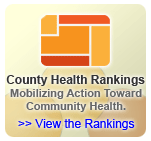Community Health Status Indicators Report


The goal of Community Health Status Indicators (CHSI) is to provide an overview
of key health indicators for local communities and to encourage dialogue about actions
that can be taken to improve a community’s health. The CHSI report was designed
not only for public health professionals but also for members of the community who
are interested in the health of their community. The CHSI report contains over 200
measures for each of the 3,141 United States counties. Although CHSI presents indicators
like deaths due to heart disease and cancer, it is imperative to understand that
behavioral factors such as tobacco use, diet, physical activity, alcohol and drug
use, sexual behavior and others substantially contribute to these deaths (see chart).
In addition to the web pages, community profiles can be displayed on maps or downloaded in a brochure format. The CHSI mapping capability allows users to visually compare similar counties (termed peer counties) as well as adjacent counties with their own county. This feature will be available when the CHSI 2009 mapping update is ready. The downloaded CHSI report allows broad dissemination of information to
audiences that may not have access to the internet.
The CHSI report provides a tool for community advocates to see, react, and act upon
creating a healthy community. The report can serve as a starting point for community
assessment of needs, quantification of vulnerable populations, and measurement of
preventable diseases, disabilities, and deaths. The CHSI report is accompanied by
a companion document entitled
Data Sources, Definitions, and Notes (PDF - 433KB). This document gives
detailed descriptions on data estimations, definitions, caveats, methodology, and
sources.
To access a community profile, select a state and county name on the left navigation
bar and select display data. The demographic characteristics of the selected county
will appear as well as its peer counties (if applicable, counties similar in population
size and frontier status). To move to another page, select the health indicator
section from the list in the left navigation bar. To print the CHSI brochure, select
the print report option at the top right-hand corner of the page; do not use the
browser print option. To access the CHSI mapping tool, select the mapping option
at the top right-hand corner of the page.
The July 2008 issue of Preventing Chronic Disease contains the following articles
that provide additional information about the Community Health Status Indicators
project:
Kanarek N, Bialek R, Stanley J. Use of peer groupings to assess county public health
status. Prev Chronic Dis 2008;5(3).
http://www.cdc.gov/pcd/issues/2008/jul/07_0145.htm.
Metzler M, Kanarek N, Highsmith K, Bialek R, Straw R, Auston I, et al. Community
Health Status Indicators Project: the development of a national approach to community
health. Prev Chronic Dis 2008;5(3).
http://www.cdc.gov/pcd/issues/2008/jul/07_0225.htm.
Heitgerd JL, Dent AL, Holt JB, Elmore KA, Melfi K, Stanley JM, et al. Community
health status indicators: adding a geospatial component. Prev Chronic Dis 2008;5(3).
http://www.cdc.gov/pcd/issues/2008/jul/07_0077.htm.
Sondik EJ. The goal of adequate data. Prev Chronic Dis 2008;5(3). http://www.cdc.gov/pcd/issues/2008/jul/07_0175.htm.
|
|
|
 d
d
|
| |
|
Source: McGinnis, J.M & Foege, W.H. (1993). Actual causes of death in the United States. JAMA., 270(18), 2207-2212
|
| |

|
| |
|